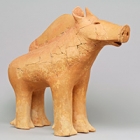Japanese Archaeology and Special Exhibition (Heiseikan) Japanese Archaeology Gallery
September 9, 2014 (Tue) - December 7, 2014 (Sun)
Haniwa are clay figures that were lined up on burial mounds from the beginning of Japan's Kofun period (ca. 3rd-7th century), and are believed to have played an important role in funerary rituals.
Early cylindrical and pot-shaped haniwa, which were produced in western Japan, developed from similar clay objects created for tombs at the end of the Yayoi period (ca. 5th century BC-3rd century AD). From the second half of the 4th or the first half of the 5th century, haniwa modeled after specific objects such as houses, parasols, armor, shields, quivers, and boats, as well as birds such as chickens and waterfowl, were also created. These haniwa were made in different sizes and their modeling also varies, reflected differences in the importance of the objects represented and the social status of those buried. In the mid-5th century, haniwa depicting people and other animals appeared. It is believed were used to portray the scenes one would see during funerary rituals.
By the end of the 5th century, the use of haniwa had extended over a vast area of Japan. From the end of the 4th century, a large number of massive "Great King" burial mounds were created near the coast of Osaka Bay. This is where most large-scale haniwa were produced, and where ones depicting humans and animals were probably first created.
This exhibition will focus particularly on haniwa from the Kinai region - where the "Great King" burial mounds are concentrated - and explore their development, visual characteristics, and the combinations in which they appeared. It will feature objects from the Furu'ichi burial mounds in Osaka Prefecture, lent to us by the Chika'tsu Asuka Museum as part of a program for the reciprocal lending of archeological objects.

